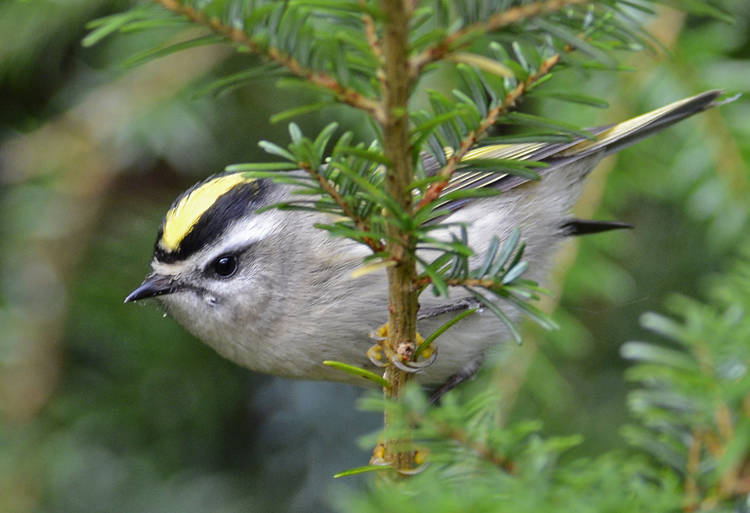By Mary F. Willson
Golden-crowned kinglets have appeared in these essays several times, but never as the main feature. So I decided to devote most of one essay to these tiny birds. I was prompted to do so on an autumn walk on the Outer Point/Rainforest Trails, when I saw a few golden-crowns right at eye level, fossicking about (and talking ) in the understory. Golden-crowns nest and often forage in the tree canopies but, especially after the nesting season, they may come down to search for semi-dormant arthropods on the twigs.
[On The Trails: Finding Noise in the Quiet]
They are resident here, staying all year (but migratory elsewhere), in contrast to the ruby-crowned kinglets, which nest here but migrate south for the winter. Golden-crowns are generally a tiny bit smaller than ruby-crowns (averaging 6 g vs. 6.5g, respectively). Both species forage chiefly by gleaning arthropods from leaves and twigs, but golden-crowns occasionally eat fruit, and are usually higher in the trees, more often in conifer than deciduous forest, usually farther out on branch tips, and they are said to be surface-gleaners more than ruby-crowns, which are often hover-gleaners. The soles of the feet of golden-crowns have grooves that are thought to be adaptations for foraging on conifer needles and twigs, facilitating clinging and hanging downward. Golden-crowns have slightly shorter hind toes and lower legs, and their bills are slightly smaller; those morphological differences may (or may not) be related to the different foraging habits, in ways yet to be determined.
Both kinglet species belong to the genus Regulus (‘little king’), which is widespread in the northern hemisphere, with six or seven species (depending on who is counting). All these species have colorful crests that can be erected at will. The ruby-crown, however, is the only one that lacks black stripes around the crest, and it is sometimes classified in a different genus. So our two kinglet species are not each other’s closest relatives. The nearest relative of the golden-crown is thought to be the goldcrest of Europe. Kinglets were formerly considered to be classified with the European warblers (taxonomic family Sylviidae), based on very similar appearance (but without the crests on warblers), but now it seems that the kinglets are classified in their own family, the Regulidae, on the basis of nuclear and mitochondrial genetics.
[On The Trails: Why do birds do things in groups?]
In winter, golden-crowns often join mixed-species foraging flocks, usually with chickadees and nuthatches, occasionally with downy woodpeckers and brown creepers. Golden-crowns may huddle together in small groups, sheltering somewhere in the conifer foliage. In the eastern U.S., there’s even a report of them going into leafy squirrel nests. They don’t have especially good insulation from their plumage, and they don’t put on fat in the fall; although they can gain a little weight by foraging each day, they lose it overnight. In cold conditions, they don’t become hypothermic, although ruby-crowns do. Instead, apparently they just gear up their metabolism and generate heat. However, bad winter storms can bring high mortality, possibly because foraging is difficult.
There are few detailed studies of breeding biology, in part because golden-crowns typically nest high in dense conifer foliage However, they are reported to nest in willow scrub on an island in Alaska. Both males and females build the nest, which is suspended from stems or twig forks near the end of a branch, and protected overhead by foliage. Many different types of materials are used, including twigs, moss, feathers, hair, lichens and so on. The nest is deep with thick walls; the inside diameter is about 4 centimeters, while the outside diameter is about 7 centimeters. In that tiny cup are laid eight or nine miniscule eggs, usually, which the female incubates for about two weeks. The male brings food to her while she does this. The nest gets crowded when the chicks hatch and grow, and their activities stretch the nest walls. The chicks fledge in about two and a half weeks, fed by both parents; they become independent of their parents after another two and a half weeks. Remarkably, the parents are reported to be capable of producing two broods of chicks a year, the pair staying together for both broods. The average life span is probably rather short, but some have been known to live about six years.
Male kinglets erect their flashy crowns during aggressive encounters and when alarmed, showing the orange-red center surrounded by the gold. I found no information on possible use during courtship nor on female displays of the golden crown. The intensity of crown color is likely to be linked to successful foraging and a supply of carotenoids that come from the diet, but its possible role in mate choice is unknown. Researchers in Ontario, where golden-crowns are migratory, suggested that more colorful crowns might reflect body condition, because more colorfully ornamented birds left earlier on southward migration.
[On The Trails: Warm December yields to deep cold]
Along our coasts, the nesting density of golden-crowns is greater along stream reaches with salmon runs than along streams without salmon, as has been shown for other species too. Golden-crowns strongly prefer intact tree canopies — their density went down after logging clear-cut various-sized patches of trees, and they avoided buffer strips, being almost absent from strips 20 meters wide.
There is much to be learned about this diminutive insectivore, both in terms of basic natural history and its ecological requirements.
Observers with good hearing may hear golden-crowns talking with their very high-pitched notes as they move through the canopy. Then, it’s fun to see if one can spot them in action, way up there.
• Mary F. Willson is a retired professor of ecology.“On The Trails” appears in the Juneau Empire every Wednesday.

